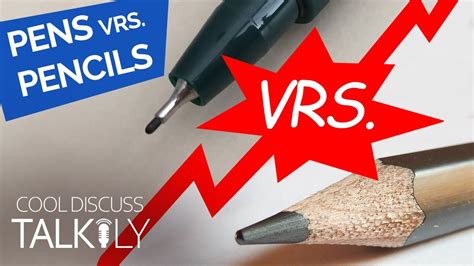In the realm of writing tools, the debate between pencil and pen has been ongoing for centuries. Each instrument boasts unique qualities that cater to distinct writing styles and applications. Whether you’re a student, an artist, or a professional, understanding the strengths and weaknesses of both pencil and pen can empower you to make informed writing decisions.

Pencil: The Instrument of Precision and Flexibility
Composition: Pencils are composed of a solid core of graphite, encased in a protective wooden or plastic sheath. The core’s composition determines the pencil’s hardness or softness, ranging from 6B (softest) to 9H (hardest).
Advantages:
- Erasable: Pencils allow for easy erasure, making them ideal for drafting, sketching, and note-taking.
- Versatile: Different pencil grades offer varying degrees of darkness and texture, enabling artists to create a wide range of effects.
- Affordable: Pencils are relatively inexpensive and widely accessible.
- Environmentally friendly: Wooden pencils can be sharpened multiple times, reducing waste.
Pen: The Instrument of Expression and Permanence
Composition: Pens come in various types, including ballpoint, rollerball, fountain, and felt-tip markers. They contain liquid ink housed in a hollow cartridge or reservoir.
Advantages:
- Permanent: The ink in pens is generally resistant to smudging, water, and fading, offering durability for documents and important notes.
- Versatile: Pens offer a wide range of colors, tip sizes, and ink types, catering to different writing styles and artistic expressions.
- Smooth writing: Pens typically provide a smoother writing experience compared to pencils, making them easier for extended writing sessions.
Pencil vs. Pen: Which is Best for You?
The choice between pencil and pen ultimately depends on your individual needs and preferences.
Choose a pencil if:
- You need the ability to erase your work.
- You prefer to create shaded or textured drawings and sketches.
- You want an affordable and easily accessible writing tool.
- You are concerned about environmental impact.
Choose a pen if:
- You need permanent and smudge-free writing.
- You desire a smoother writing experience.
- You want to explore artistic expression with various colors and tip sizes.
- You prefer the aesthetic appeal and perceived formality of penmanship.
Applications of Pencil and Pen
Education: Pencils are commonly used for drafting and sketching, while pens are preferred for note-taking and essays.
Art: Pencils are essential for sketching and drawing, while pens are used for inking and creating detailed line art.
Business: Pens are generally preferred for formal documents, contracts, and signatures, while pencils can be used for note-taking and brainstorming.
Science: Pencils are often used in scientific diagrams and sketches, while pens are used for recording data and writing scientific reports.
Innovative Applications
Pencil:
- Develop a pencil that can change hardness or softness with a twist of the tip.
- Create a pencil that incorporates a built-in eraser, eliminating the need for separate erasers.
- Design a pencil with a built-in stylus for digital note-taking.
Pen:
- Invent a pen that can automatically adjust ink flow based on writing speed and pressure.
- Develop a pen with built-in connectivity, allowing for digital sharing of handwritten notes.
- Create a pen that offers customizable ink colors through interchangeable cartridges.
Tips and Tricks
Pencil:
- Sharpen your pencil regularly for a smooth writing experience.
- Use a light touch to avoid breaking the graphite core.
- Experiment with different pencil grades to achieve various effects in drawing and sketching.
Pen:
- Choose the right pen type for your writing style and application.
- Store pens upright to prevent ink leakage.
- Blot fresh ink with paper towels to prevent smudging.
Common Mistakes to Avoid
Pencil:
- Using a dull pencil can lead to uneven strokes and frustration.
- Applying too much pressure can break the graphite core or tear the paper.
- Erasing too aggressively can damage the paper surface.
Pen:
- Leaving the pen uncapped can cause the ink to dry out or evaporate.
- Writing with excessive force can damage the pen tip or ink cartridge.
- Choosing the wrong pen type for your application can lead to unsatisfactory results.
FAQs
1. Which is more environmentally friendly, pencil or pen?
- Pencils have a lower environmental impact than pens, as they can be sharpened multiple times, reducing waste.
2. Can you erase pen ink?
- Most pen inks are permanent and cannot be erased, although certain specialty erasers and cleaning fluids may work on some types of ink.
3. Which is better for cursive writing, pencil or pen?
- Pens provide a smoother writing experience, making them more suitable for cursive writing than pencils.
4. What type of pen should I use for signatures?
- For legal documents and contracts, it is best to use a ballpoint or rollerball pen with permanent ink.
5. Can I use a pencil in a fountain pen?
- No, fountain pens are designed specifically for liquid ink and will not work with pencils.
6. How long do pencils and pens typically last?
- The lifespan of a pencil or pen varies depending on factors such as usage, care, and type. Pencils can last for several months, while pens can last for weeks or months, depending on their ink capacity and usage.
Conclusion
The choice between pencil and pen is a matter of personal preference and specific writing needs. Pencils offer the advantages of erasability, versatility, and affordability, while pens provide the benefits of permanence, smoothness, and aesthetic appeal. By understanding the unique strengths and weaknesses of each instrument, you can harness their power to unlock creativity, enhance precision, and effectively communicate your ideas in written form.
